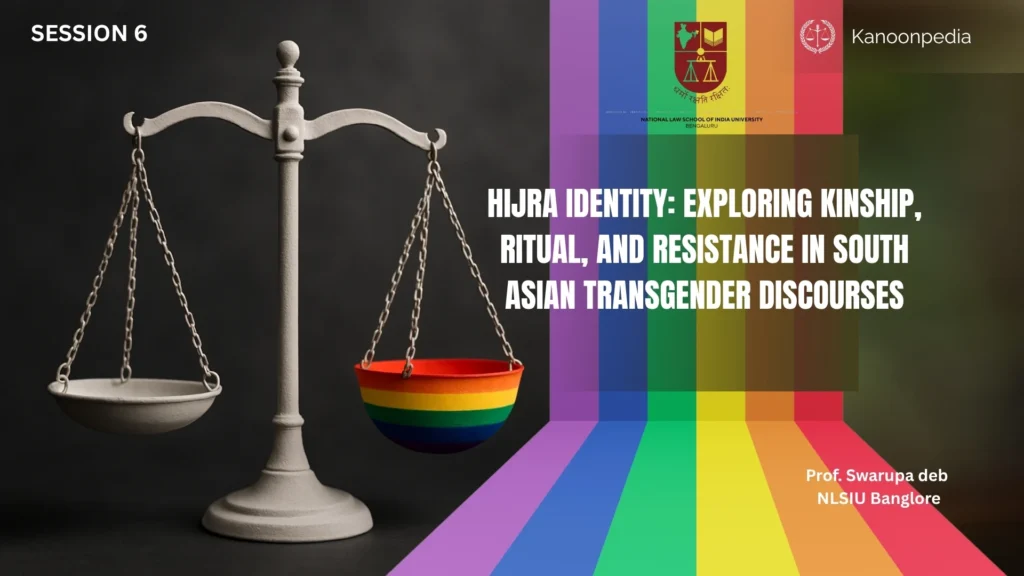Key takeaway: The hijra identity emerges through a complex interplay of kinship, ritual renunciation, and posthuman resistance, transcending reductive tropes of transgender politics.

Table of Contents
Introduction
The term hijra-identity refers to South Asian gender-diverse communities whose experiences challenge Western frames of transgender rights and embodiment. Hijras craft social personhood not merely through bodily transition but via communal kinship (gharanas), ritual practices, and ethical renunciation that confer izzat (respect). Understanding hijras demands moving beyond identity-politics tropes to a posthuman lens that foregrounds fluidity, spirituality, and resistance.
Transgender as Identity Politics and Hijra Identity
Within rights-based frameworks, transgender bodies are medicalised, regulated by the state, and socially objectified. This lens treats the hijra identity primarily as a locus of violence and discrimination—ignoring how hijras themselves articulate personhood beyond genital-focused narratives. While legal recognition and healthcare access are crucial, the hijra community resists reducing identity to biomedical markers of transition.
Transgender as Posthuman Phenomenon and Hijra Identity
The hijra identity also exemplifies posthumanist thought by unsettling rigid human/animal, body/self dualities. Hijras enact fluid selves through technological and ritual mediation—piercing, sartorial markers, and devotional performances—rejecting a fixed “pure” human form. This posthuman reading reveals how hijra bodies transcend boundaries, performing identities that exceed conventional gender embodiment.
Co-Existence of Political and Posthuman Dimensions
Hijras navigate dual roles: advocating rights and dignity (identity politics) while experimenting with bodies as sites of performative renunciation. Their hijra identity embodies both legal struggles—fighting violence, misrecognition, and bureaucratic barriers—and radical redefinitions of life that question what it means to be human and gendered.
Gayatri Reddy’s Ethnography: Ritual and Izzat in Hijra Identity
Gayatri Reddy’s work on hijras emphasizes that hijra identity is less about state validation and more about communal kinship structures and ethical practices:
- Gharana Kinship: Hijra communities organize into gharanas headed by a Nayak (community leader), with gurus and chelas forming hierarchical, interdependent families. Each newcomer undergoes nose and ear piercing and receives a new name, solidifying their hijra-identity through ritual adoption.
- Izzat (Respect): Izzat is the cornerstone of hijra-identity, cultivated through devotion to deities like Bahuchara Mata, communal festivals, and acts of blessing. Performing rituals—mangti (begging for alms), badhai (blessings at births and weddings), and dhanda (sex work)—reinforces social value.
- Economic and Social Support: Gharanas function as joint-family units, offering shelter, healthcare, and social security. This network sustains the hijra-identity beyond familial rejection, embedding individuals in a community where decisions by the Jamaat (community council) are supreme.
Gharana Structure and the Formation of Hijra Identity
The gharana system shapes hijra identity through:
- Initiation Rituals: Newly recruited hijras undergo gold piercing gifts from gurus, symbolizing rebirth into the community.
- Name Bestowal: A new name marks departure from natal kin, asserting a collective persona.
- Spiritual Devotion: Regular worship and festivals reinforce ethical frameworks, linking hijra identity to sacred lineage.
Hijra-Identity and Ritual Renunciation
Renunciation is central to hijra-identity. Hijras invoke sannyasi ethics—renouncing family, property, and traditional gender norms. Bodily transformations (castration or hormonal changes) are ritual acts symbolizing spiritual rebirth rather than solely medical transitions. This perspective situates the hijra identity within a broader discourse of sacrifice, sanctity, and performative respectability.
Conclusion
The hijra-identity cannot be fully understood through Western transgender paradigms alone. It emerges from kinship-based gharanas, ritualized izzat, and posthuman performances that transcend binary gender frameworks. Recognizing these dimensions enriches our understanding of global gender diversity and challenges reductive models of transgender identity.
Practice Questions
Describe how gharana kinship rituals contribute to the formation of hijra identity.
Gharana kinship rituals—initiation through piercing, name bestowal, and hierarchical guru-chela relationships—forge collective belonging, marking individuals’ rebirth into the hijra community.
Explain the role of izzat in sustaining hijra communities and individual respect.
Izzat (respect) is maintained through devotional practices, blessing customs (badhai/mangti), and communal festivals, reinforcing social value and economic sustenance within gharanas.
Discuss how a posthuman lens reshapes our understanding of hijra embodiment.
The posthuman lens highlights ritual and technological mediation—piercing, sartorial codes, spiritual performances—showing hijra bodies as fluid, sacred sites beyond binary norms.
Session 7 Understanding Transgender Identity Through History, Science, and Public Discourse
[…] gender concept conflates diverse non-binary roles into one static category (typological error).It naturalizes binary sexual […]